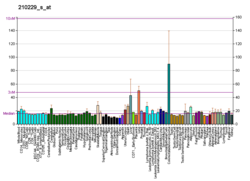| CSF2 |
|---|
 |
| Estructures disponibles |
|---|
| PDB | Cerca ortòloga: PDBe RCSB |
|---|
| Llista de codis id de PDB |
|---|
1CSG, 2GMF, 4NKQ, 5C7X, 5D70, 5D71, 5D72, 4RS1 |
|
|
| Identificadors |
|---|
| Àlies | CSF2, GMCSF, colony stimulating factor 2, CSF |
|---|
| IDs externes | OMIM: 138960 MGI: 1339752 HomoloGene: 600 GeneCards: CSF2 |
|---|
| Localització del gen (ratolí) |
|---|
 | | Cr. | Cromosoma 11 (ratolí)[1] |
|---|
| | Banda | 11 B1.3|11 32.13 cM | Inici | 54,138,097 bp[1] |
|---|
| Fi | 54,140,493 bp[1] |
|---|
|
| Patró d'expressió d'ARN |
|---|
| Bgee | | Humà | Ratolí (ortòleg) |
|---|
| Més explicacions | - upper lobe of left lung
- vesícula biliar
- stromal cell of endometrium
- apèndix vermiforme
- illot de Langerhans
- teixit muscular
- múscul llis
- recte
- medul·la òssia
- gangli limfàtic
|
| | Més explicacions | - left lung lobe
- right lung lobe
- jejú
- duodè
- piriform cortex
- artèria
- haematopoietic system
- tim
- còlon
- carotid body
|
| | Més dades d'expressió de referència |
|
|---|
| BioGPS |  | | Més referències a dades d'expressió |
|
|---|
|
| Ontologia genètica |
|---|
| Funció molecular | - growth factor activity
- granulocyte macrophage colony-stimulating factor receptor binding
- unió proteica
- protein tyrosine kinase activity
- cytokine activity
| | Component cel·lular | - regió extracel·lular
- intracellular membrane-bounded organelle
- extracel·lular
| | Procés biològic | - negative regulation of cytolysis
- positive regulation of macrophage derived foam cell differentiation
- regulation of cell population proliferation
- MAPK cascade
- positive regulation of podosome assembly
- negative regulation of extrinsic apoptotic signaling pathway in absence of ligand
- positive regulation of interleukin-23 production
- positive regulation of gene expression
- embryonic placenta development
- epithelial fluid transport
- regulació de l'expressió gènica
- dendritic cell differentiation
- myeloid dendritic cell differentiation
- macrophage activation
- cellular response to lipopolysaccharide
- resposta immunitària
- monocyte differentiation
- response to fluid shear stress
- response to silicon dioxide
- neutrophil differentiation
- peptidyl-tyrosine phosphorylation
- regulation of circadian sleep/wake cycle, sleep
- histamine secretion
- positive regulation of tyrosine phosphorylation of STAT protein
- cellular response to granulocyte macrophage colony-stimulating factor stimulus
- regulation of myeloid cell differentiation
- regulation of signaling receptor activity
- negative regulation of transcription, DNA-templated
- cytokine-mediated signaling pathway
- positive regulation of cell population proliferation
- macrophage differentiation
| | Fonts:Amigo / QuickGO |
|
| Ortòlegs |
|---|
| Espècies | Humà | Ratolí |
|---|
| Entrez | | |
|---|
| Ensembl | | |
|---|
| UniProt | | |
|---|
| SeqRef (ARNm) | | |
|---|
| SeqRef (proteïna) | | |
|---|
| Localització (UCSC) | n/a | Chr 11: 54.14 – 54.14 Mb |
|---|
| Cerca a PubMed | [2] | [3] |
|---|
|
| Wikidata |
| Veure/Editar Humà | Veure/Editar Ratolí |
|
| Factor estimulant de colònies de granulòcits i macròfags |
| Identificadors |
| Símbol | ? |
El factor estimulant de colònies de granulòcits i macròfags (GM-CSF, de l'anglès Granulocyte-macrophage colony-stimulating factor), també conegut com a factor estimulant de colònies 2 (CSF2), és una glicoproteïna monomèrica secretada per macròfags, limfòcits T, mastòcits, cèl·lules NK, cèl·lules endotelials i fibroblasts que funciona com una citocina. Els analògics farmacèutics de GM-CSF que es produeixen de manera natural s'anomenen sargramostim i molgramostim.
A diferència del factor estimulant de colònies dels granulòcits, que promou específicament la proliferació i maduració de neutròfils, el GM-CSF afecta més tipus de cèl·lules, especialment els macròfags i els eosinòfils.
Referències
- ↑ 1,0 1,1 1,2 GRCm38: Ensembl release 89: ENSMUSG00000018916 - Ensembl, May 2017
- ↑ «Human PubMed Reference:». National Center for Biotechnology Information, U.S. National Library of Medicine.
- ↑ «Mouse PubMed Reference:». National Center for Biotechnology Information, U.S. National Library of Medicine.






